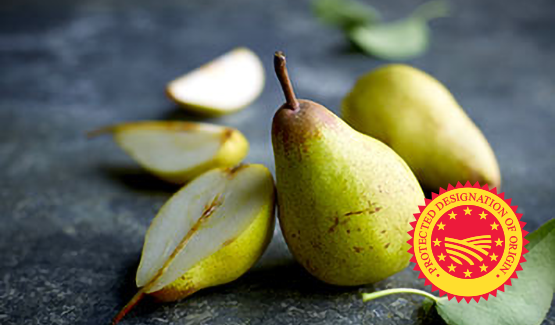Perched on the Atlantic edge of Europe, the orchards that produce Pêra Rocha do Oeste PDO stem from a single tree, discovered by chance on a farm in the Sintra region of Portugal over 150 years ago.
The yellow-green skin of Pêra Rocha do Oeste PDO is lightly freckled on top and blushed on the sunny side, while its flesh is juicy, sweet, and distinctively aromatic.

Origins
In 1836, Pedro António Rocha happened upon a unique and unknown variety of pear tree on his farm in Sintra, a region located between Lisbon and the Atlantic Ocean.
Discovering that the tree bore exceptional fruit, Rocha would invite his friends and neighbours over to his farm every September to sample and enjoy the produce. As Rocha shared grafts of the tree with his friends, the variety quickly spread across the Oeste region, becoming known as Pêra Rocha in honour of its discoverer.
That such a unique variety of pear could emerge spontaneously on Rocha’s farm is down to the natural micro-climate of the area. Buffeted by sea winds and sheltered under the Sintra mountains (historically known as Lunae Mons, or the mountains of the moon), the region is layered with soils that date back to the Jurassic and neo-Jurassic periods. As well as the nurturing qualities of the soil, the pears require a period of winter cold in order to develop properly, while the summer sun bestows a pink tinge upon their skin.
Nearly ninety years after its discovery, the pear was officially recognised as a distinct variety at the 2nd National Pomology Conference in Alcobaça, Portugal. At the conference, the agricultural manager Guilherme Joaquim da Matta spoke of his visit to Rocha’s farm:
…several people in Ribeira de Sintra said they knew the “Rocha” pear tree from which the first grafts had been taken… they showed me the particular pear tree, situated in a small ditch separating the orchard from the arable land... One thing that struck me straight away as being noteworthy was the robustness of the tree. In fact, I was looking at a specimen which I realised, from its appearance and information given by the elderly people present, was no less than 90 years old.
By this time, the distinctive characteristics of the Pêra Rocha do Oeste had not only been recognised by the scientific community, but also by consumers and food lovers, as the pear quickly became a symbolic product of its region.
In 2003, the European Union also recognised the unique qualities of Pêra Rocha do Oeste by certifying the product as a protected designation of origin (PDO).
Production
Pêra Rocha do Oeste PDO is produced and packaged in twenty nine communes of the Oeste region (so-called because it is the most westward region of Portugal).
Local expertise is carefully applied to the cultivation of orchards. As the specific weather conditions of the region are essential for the fruit to fully develop, the breeding, treatment, and harvesting of the pear trees are all timed to the tune of nature.
Picking begins on the second fortnight of August and is often a community effort. Every year, 15,000 workers help to harvest roughly 173,000 tonnes of pears. In some orchards, picking is still performed by hand in the traditional fashion, by holding the fruit and tilting it slightly to avoid causing damage to the stem.
Once picked, the pears are stored alongside the trees in rows of boxes. The boxes are then transported to the fruit warehouse, where the pears are batch-coded, labelled and stored in cool conditions. Known for its good keeping qualities, Pêra Rocha do Oeste PDO can be found on shop shelves and fruit bowls from August to May.
Crisp and crunchy at first, the pear sweetens and softens over time, its flesh becoming more creamy and juicy (a process known as “melting” in pear parlance). Another distinguishing feature is the sugar-flecked russeting (speckled bronze areas with a slightly rougher texture), which can be found around the base and stem of the pear.
While often used in salads, liqueurs and fruit juices, the sweetness of Pêra Rocha do Oeste PDO makes it a particularly popular ingredient for desserts.
More information
Pêra Rocha do Oeste PDO – legal specifications



